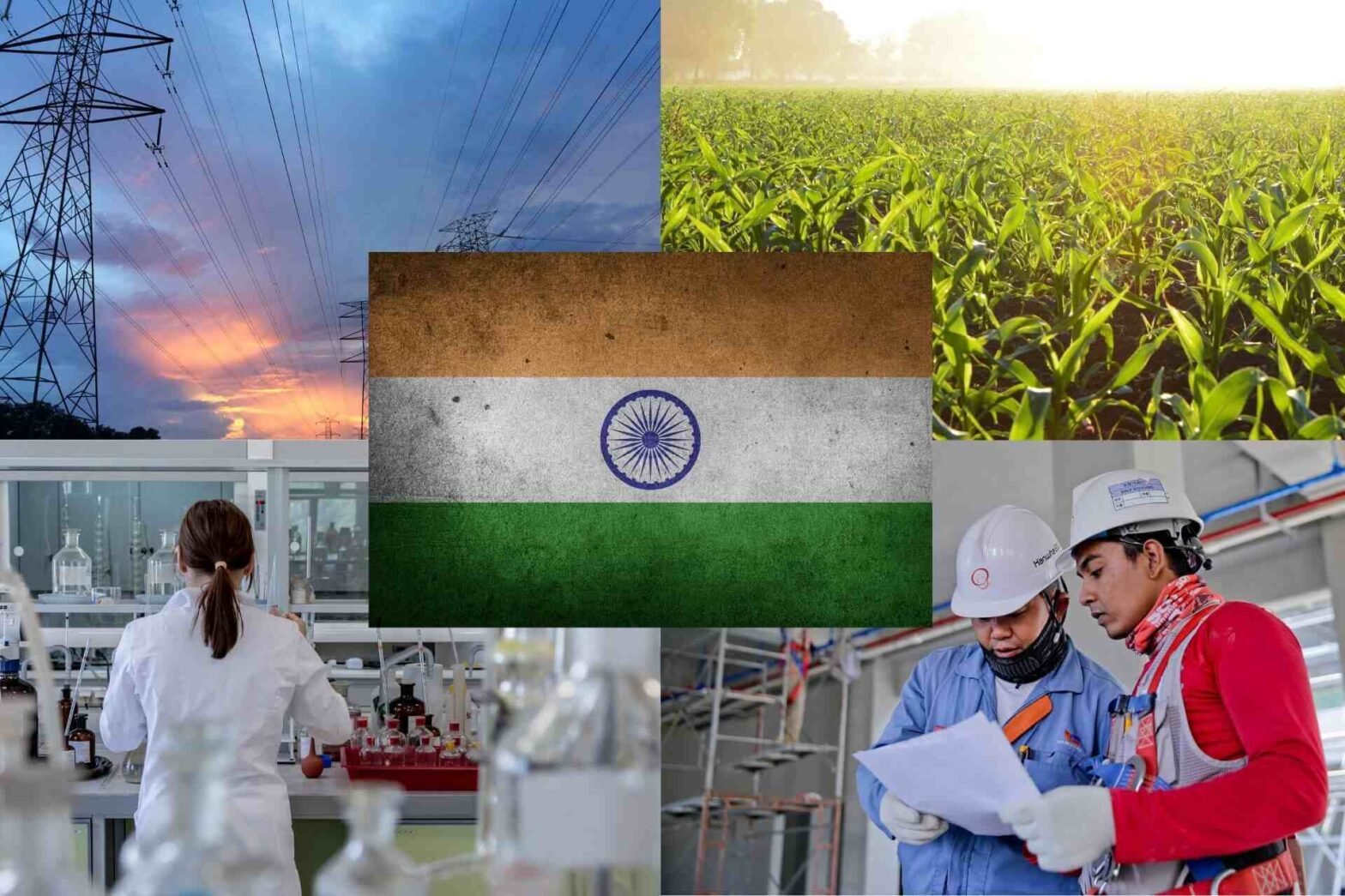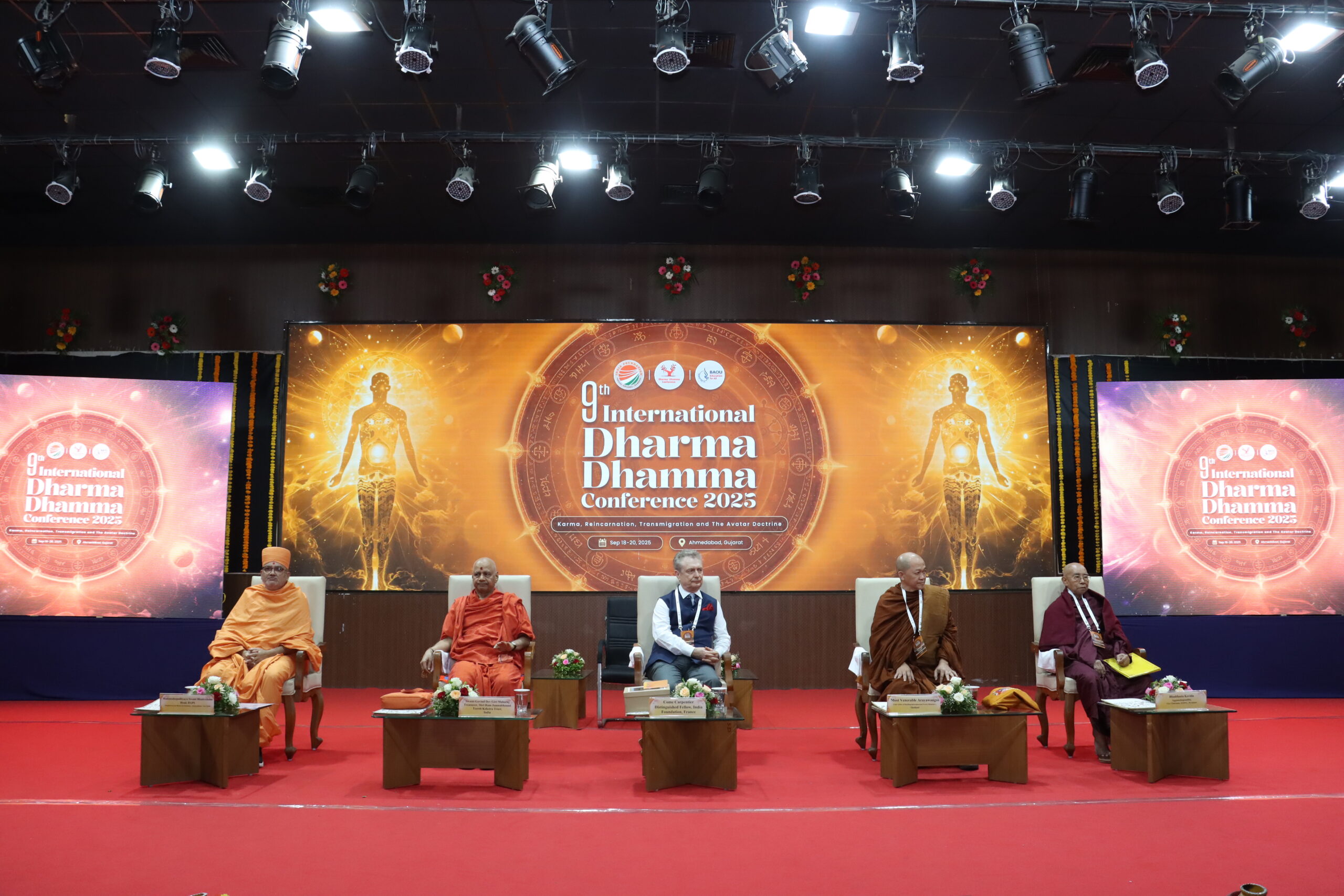The hall mark of Modi 2.0, Atmanirbhar Bharat Abhiyaan (ABA), is an unprecedented paradigm shift in the history of Indian economics post-independence. It has not only turned a crisis into an opportunity for professionals and entrepreneurs with its unique approach towards a financial problem emanating from an unprecedented event ever in history but also awakened India to its inherent inner strength and inward intuitive capacities based on Indian systems of knowledge and thought.
The raging C-19 pandemic, resulted in a deep crisis where mankind was pushed to its edges on all fronts—health, education, vocation and aspirations. Taking a unique, yet Bhārtiya (Indian) rooted approach for the growth of business and trade, backed by a strong domestic input—human effort and material utilisation, the economy has bounced back and seems to be on upward climb now, as per the most recent RBI projections.
Through ABA, Modi 2.0 has not only brought out an economic package based on swadeshi economics but a new economic philosophy that, apart from mind-set shift, also provides us with a holistic ‘arthanīti’ or economic management. It bears significant similarities to the Gandhian economic model, left largely neglected after Independence. Gandhian economic thought was based on the pillars of swaraj and swadeshi and was itself an outcome of Gandhi’s extensive and in depth understanding of classical Indian literature.
ABA has succeeded in projecting and bringing out to the world an alternative humane economics (entrenched in the Indian mind for thousands of years), ensuring dignified human expression of moral character and personal ingenuity. ABA is not just a policy but a constructive programme aimed towards human empowerment and development through the human power entrenched within our civilisation over many millennia.
Ample evidence illustrates the uncanny similarity and inspiration of the ABA from the terra firma of Gandhian principles of self-reliance (swadeshi) and complete independence (non-dependence: swaraj) in thought, praxis and lifestyle. Gandhi was opposed to the centralised economy built on Nehru- Mahalanobis model of building behemoths and working single-mindedly on the aim of import substitution.
ĀtmanirbharBhāratAbhiyān and Gandhi’s Constructive Programme
Lockdown affected lives, livelihoods and standards of living adversely—both economic and non-economic, of all individuals. On 12 May 2020, the Prime Minister first talked about building an ĀtmanirbharBhārat[i]. The call was to the masses to collect themselves, assert their human power, sweat for bread but purely on moral grounds. Modi’s words were not about policy or politics but collective action, much like Gandhi had done in a bid to make each and every Indian self-respecting, self-sufficient and self-reliant in order to seek true independence of mind, body and soul.
In his independence speech on 15 August2020, Prime Minister Narendra Modi invoked Subramania Bharti’s maxim for action, quoting him: ‘India will show the way forward to the entire world to break free from every bondage.’[ii] Many of his critics wrote a scathing attack of the ABA, a philosophy clearly spelt out by Modi on 12 May 2020 on All India Radio’s ‘Mann ki Baat’[iii]. Gandhi, too, faced a similar criticism on his call for collective economic action being accused of being utopian and unrealistic[iv].
Like Gandhi, Modi, too remained resilient, probably following in the footsteps of the Father of the Nation, with focus on a larger moral goal to surmount the indomitable crisis at hand. Gandhi was of the view that any paradigm shift requires a strong moral force involving all individuals and an Indian way of doing things. ABA, too, is based on the belief that its success lies in mass moral development and spiritual force; a calling that India has taken well to as suggested by statistics on rising production, consumption and unprecedented achievements in research and development.
Ātamanirbharta is akin to poorna swaraj. Modi stated that self-reliance or atmanirbharta must ensure justice for poor, equal opportunity for all, the lower and middle classes should not face any obstacle to their growth, government should not come in their way as well as of social systems such that their dreams are not curbed in anyway[v]. This resonates with Gandhi’s view of minimum governance and maximum self-governance with government acting as a facilitator for economic growth and human welfare. The considerations of both ABA and Gandhian economics are derived from the principle that seeks to enable every person in a manner that the person can fully develop all faculties and thereby personality in a spirit of true swaraj[vi].
For both of them, the success of anyabhiyān, requires training on the back of moral and spiritual self-discipline[vii]. A strong self-reliant India will then (and has) maintain a steady pace of growth and enjoy the good will of the world[viii]. Modi states that big aims are important even if we don’t hit the bull’s eye[ix]. Aims should be big, targets far sighted and decision making fast. Vague targets and weak spirits are a mark of a stagnating society.
The five pillars of ABA are economy, infrastructure, information technology-based systems, vibrant demography and demand. Interestingly, all find enumeration in some form in Gandhi’s Constructive Programme. The objective is to make India unconditionally dependent on local vendors by building an active base of supplies from needles to buttons to generators to chemical compounds.
The case in point is the massive 20 lakh crore package, equivalent to 10 per cent of India’s gross domestic product (GDP) launched with the objective of making Indian economy truly swadeshi[x]. Gandhian village economy, too, was designed to drift from global to local and make India dependent on local supply chains with the hinterland supporting the needs of the main cities[xi]. In fact, much in line with this, the government has decided to give preference to those commercial contracts that source inputs from local vendors. From boosting fisheries and building farm gate infrastructure, to cluster-based approach for mangoes, kesar or saffron, bamboo, chilli and tapioca, the idea is to build a swadeshi backbone for local sourcing to meet the demands of 130 crore people. While government hand-holding was not something Gandhi envisaged, we must remember that Modi 2.0 is a paradigm shift but not working on a clean slate, for which Gandhi’s Constructive Programme was written.
Modi 2.0, with its path breaking human development plan, brings within its ambit the notions of self-sufficiency, non-violence and truth (swadeshi, satya and ahimsa). The socio-economic development programme means to find all the necessaries of life in one’s own mother land while giving impetus to private or individual co-operation. It does not shun foreign co-operation but implies significant reversal of external dependence of goods. Business are being opened up and investments attracted with the caveat of ‘Make in India’[xii]. To promote ethical choices, Modi calls for the mantra of ‘local’ under the ABA. In times of crisis, it is the local that has fulfilled our demand and saved the nation from great crises[xiii].
ABA has done exactly that by weaving in migrants, the village industries, local producers, textile manufacturers, the potters, the toy makers and the craftsmen[xiv]. This Gandhian decentralised economy, which involves the true Indian spirit on ground is a cornerstone of the ABA. It focuses on participation of tier 2 and 3 towns with hundred percent backward linkage from the village as a support system[xv]. Modi 2.0 revives the Indian ethos with a new fervour largely absent in our political history since independence. Interestingly, ABA too, focuses on decentralisation of industry flooding start up enterprises in tier 2 and 3 towns, contrary to the Nehru-Mahalanobis model that was forced upon independent India. While we talk of towns, we must be mindful that some of the major villages of the nation in Gandhi’s times have now collectively grown to become such towns on account of demographic growth and connectivity—both physical and digital.
Historically, the farmer has not been able to decide the price of what he produces. Its price is calculated on the basis of the material investment, completely obliterating the sweat equity—empty nights spent guarding the crop, waiting for crops to grow without any other form employment etc. This was a major complaint that Gandhi had against the evil of demand and supply price determination in agriculture. It is backed by the logic that money drives away land from food to commercial crops like tobacco[xvi].
ABA is the first attempt to restore the dignity of the farmer by accounting for the abstract efforts that going into the entire process of growing food. As enablement and in a bid to prevent exploitation of farmers the minimum support price (MSP) has been raised to one and a half times of the investment made by the farmer in phase 3 of ABA[xvii]. The price given to him is no longer mapped to the physical monetary investment but on the human effort as well.
ABA attempts to give impetus to technology driven systems. This was one of the major reasons that Gandhi had strongly criticised the use of technology especially the railways by the British[xviii]. Thus, to many, these may look departures on the two sides. However, Gandhi’s reason was not to become slaves of technology but to use it to enhance human dignity and effort. Good or evil lies in the intention, not in the means alone. Thus, with a clear goal setting, ABA is not a major departure from the Gandhian ethical framework.
Artificial intelligence, machine learning, robotics are aimed to penetrate those regions where human to human contact is not possible or in dealing with minutiae where human skill is limited[xix]. Thus, ABA focuses on technology driven and not technology dependent systems. Apart from aiming at economic efficiency this also aims at reducing the harm to environment per unit of income produced rather than producing more income per unit of pollution, as envisaged by Gandhi[xx].
It has brought a much needed change in approach for the growth and efficiency of the health sector in the wake of the COVID 19 crisis[xxi]. To be self-reliant in this sector given the global crisis we stand amidst, India’s PPE (personal protective equipment) manufacturers rose from zero in march to about 300 by August 2020. India today is the largest manufacturer for the C-19 vaccine. ABA programmes are working with enhanced government spending for community development and engagement in village works, grass root development through construction of highways, houses, toilets and record food production[xxii]. It commands a change in taste of the people of India towards building brand India, akin to Gandhi’s Constructive Programme[xxiii].
Gandhi’s extensive writings in ‘Young India,’ a weekly journal published between 1919-1931, aimed to mobilise youth for a sustainable economy[xxiv]. Similarly, the ABA intends to capitalise on the demography of the country where 50 per cent of the population is below the age of 25 years and the average age of the Indian population is 29 years[xxv]. For Gandhi, supply and demand economics was one of the major forms of evil[xxvi]. He envisaged an economic order where people are motivated by meeting needs and not creating an excess of supply or suppressing supply in order to push up profits and prices. This is what the ABA intends through local sourcing and strengthening the economy till the grassroots.
The ABA also talks of creating a self-sustaining economy where India will witness a demand of goods based on the strength of utilising the full capacity of the internal supply chain[xxvii]. Supply will not cater to profit or price but will be based on genuine demand. Modi 2.0 is creating a strong supply system built on labour and Indian means of transfer and exchange[xxviii]. All countries have a right to protect their trade. ABA aims to boost growth and trade within the motherland through technology transfer and seeking investment[xxix]. Gandhi, was of the view that the charge of protectionism in trade was not a negative one[xxx]. This is where ABA takes a leap beyond Gandhi. Even as we abide by swadeshi economics, we continue to meet obligations under the World Trade Organisation’s (WTO) agreement.
Centralisation producesfinancial slaves for Gandhi[xxxi]. Higher the so-called standard of living based on a material driven economic index, the tighter is the noose around the neck. In order to solve moral, spiritual and social problems, independent economic activity must be encouraged and method put in place for economic practice, according to the Gandhian model. This is exactly the aim of the ABA along with a keen eye on economic parameters. ABA is a mass movement which has become the soul force of 125 crore efforts. Current government reforms involving relinquishing control in some major sectors will crowd in private investments and increase people partnership in businesses.
Conclusion
With the motto ‘shramevajayate,’ ABA is providing last mile delivery, which is reflected in economic parameters on the back of growing domestic demand and spending being the principle for action. The Sanskrit phrase means ‘hard work alone wins’ and is a new age version of the dictum given by Gandhi ‘satyamevajayate’ or truth alone wins, for hard work is born out of earnestness.
Modi 2.0 talks of ‘sabkasaath, sabkavikas’ for the first time in 75 years of independence[xxxii]. It aims not only at inclusive development but sowing the seeds of self-dependence at the very grass roots rather than propping up already existing large scale centralised manufacturing and services. Modi 2.0 endorses this Gandhian view when he states that economic development is important but human dignity is supreme. ABA captures the debate which is shifting from economy centric globalisation to human centric globalisation[xxxiii]. The growth is beyond GDP numbers yet inclusive of it because it is human development (holistic) and not just economic development (a shift that is being sought by modern economists).
With ABA, Modi 2.0 sets the ground rule that human dignity stands supreme over economic development[xxxiv]. Shunning myopic vision, Modi 2.0 launched the mantra of co-operation[xxxv]. It aims to develop 125 crore active citizens from over 6 lakh villages into nation builders, similar to the Gandhian ethical economic model[xxxvi]. ABA brings to the fore a knowledge-based economy to a civilisation that has always been knowledge driven. According to Gandhi, the focus should be on quality in the method of production which is dictated by complete knowledge of the means and sources of production[xxxvii].
Almost all super economic powers have high growth rates and higher production levels but they do not enjoy the tag of civilisational progress that is based on the moral and spiritual development of people which has been inherent in the Indian mind in thought, action and spirit right from an auto-rickshaw driver to a company CEO (chief executive officer). ‘Sabka saath, saathvikas’ is a philosophy in action on ground. Industry produces for exchange but a mother for home and that is the business ethics engendered in the ABA. Gandhi was of the view that ethical considerations are not disturbing to the economic or business apparatus of a society[xxxviii]. According to him, the notions of ‘pure,’‘good,’‘right,’ have universal connotations and maintain the same import whether we talk of good economics or good ethics. In other words, the two are equivalent.
Modi 2.0 effectively bats on the same ideological pitch reinforcing that good economics is ethics. It endorses and propagates the view that swadeshi movement is as workable as any other ever envisaged by human beings based on ‘an indomitable will of a band of earnest workers’[xxxix]. Modi 2.0 is a moral economic approach and a human public policy structure for modern times with an attempt to remodel and work on humanitarian presumptions and human centric development rather than an economics of numbers alone.
Ethically good practices do not involve continuing losses or short-term gains. If they are ethical in nature, both means and ends have to aim at welfare and growth[xl]. The mantra is to spread out and reach grass roots for Modi 2.0. It has a philosophy that growth whether moral, physical, material, spiritual or otherwise must be an outcome of ‘good’ economics. ABA weaves in practical ethics or relative dharma. It is a shift towards holistic humane goals of swadeshi and self-sufficiency. Like Gandhi, here too, the individual is the unit for action rather than groups and classes[xli].
Modi 2.0 has launched a philosophical leap in public policy. Much like Gandhi, self-belief and inner strength is the mark for the quest for self-dignity and self –reliance[xlii]. It is a change in mind set for a billion of us, not an incremental move.
Modi 2.0 has launched a festival of self-reliance through the ABA[xliii]. ‘Esha Panthah’ – this is the path for a self-sufficient India. Thus, it celebrates Gandhi’s 150th year, both in spirit and action in a unique way.
Author Brief Bio: Gunjan Pradhan Sinha is an academician, journalist and independent researcher. She is the author of the book Dharma in Governance and has published over 2000 articles as a columnist in leading Indian dailies such as The Indian Express, The Economic Times and The Financial Express. In the initial part of her career, she plunged into a career of journalism writing extensively on public policy issues spanning over 8 years. She taught Philosophy at St. Stephen’s College for over 8 years from where she graduated as well. She also taught at Lady Shri Ram College, Miranda House and Jindal Global University. Currently, she teaches business ethics at Bhavan’s Usha Lakshmi institute of management.
[i] Modi, Narendra. May 12, 2020 Speech. https://timesofindia.indiatimes.com/india/full-text-pm-modis-address-to-nation-on-covid-19/articleshow/75702461.cms
[ii] Modi’s Independence Day Speech, https://www.narendramodi.in/text-of-prime-minister-shri-narendra-modi-s-address-to-the-nation-from-the-ramparts-of-the-red-fort-on-the-74th-independence-day-august-15-2020-551013 (New Delhi: August 15, 2020)
[iii] Modi, Narendra. May 12, 2020 Speech. https://timesofindia.indiatimes.com/india/full-text-pm-modis-address-to-nation-on-covid-19/articleshow/75702461.cms
[iv] Gandhi, Mohandas Karamchand. Constructive Programme,Navajivan Trust Revised 1945, Ahmedabad: 2010.
[v] Modi’s Independence Day Speech, https://www.narendramodi.in/text-of-prime-minister-shri-narendra-modi-s-address-to-the-nation-from-the-ramparts-of-the-red-fort-on-the-74th-independence-day-august-15-2020-551013 (New Delhi: August 15, 2020)
[vi] Kumarappa, J C. Motives and Indian Economy, Chapter 1. Gandhian Economic Thought. Sarva Seva Sangh Prakashan. Rajghat, Varanasi: 1951. pp 15-16. www.mkgandhi.org accessed September 10, 2020.
[vii] Gandhi, Mohandas Karamchand. Constructive Programme, Navajivan Trust Revised 1945, Ahmedabad: 2010.pp3-5.
[viii] Modi’s Independence Day Speech, https://www.narendramodi.in/text-of-prime-minister-shri-narendra-modi-s-address-to-the-nation-from-the-ramparts-of-the-red-fort-on-the-74th-independence-day-august-15-2020-551013 (New Delhi: August 15, 2020)
[ix] Ibid.
[x] Modi, Narendra. May 12, 2020 Speech source- https://timesofindia.indiatimes.com/india/full-text-pm-modis-address-to-nation-on-covid-19/articleshow/75702461.cms
[xi] Gandhi, M K. Khadi. Constructive Programme. Navajivan Trust Revised 1945, Ahmedabad: 2010.pp 10.
[xii] Modi, Narendra. May 12, 2020 Speech. https://timesofindia.indiatimes.com/india/full-text-pm-modis-address-to-nation-on-covid-19/articleshow/75702461.cms
[xiii] Modi, Narendra. May 12, 2020 Speech. https://timesofindia.indiatimes.com/india/full-text-pm-modis-address-to-nation-on-covid-19/articleshow/75702461.cms
[xiv] Self-Reliant India Movement. Ministry of Finance. Government of India. Phase I. file:///C:/Users/Gunjan/Desktop/Business%20Ethics/Aatmanirbhay%20phase%201.pdf
[xv] Self-Reliant India Movement. Ministry of Finance. Government of India. Phase I. file:///C:/Users/Gunjan/Desktop/Business%20Ethics/Aatmanirbhay%20phase%201.pdf
[xvi] Kumarappa, J C. Agro Village Industries, Chapter 3. Gandhian Economic Thought, Sarva Seva Sangh Prakashan. Rajghat, Varanasi: 1951. Pp14 www.mkgandhi.org accessed September 10, 2020.
[xvii] Ministry of Finance https://web.archive.org/web/20200612121248/https://cdnbbsr.s3waas.gov.in/s3850af92f8d9903e7a4e0559a98ecc857/uploads/2020/05/2020051736.pdf
[xviii] Gandhi, M K. Hind Swaraj. Chapter XIX. Navajivan Trust. Ahmedabad: 2000. pp53
[xix] Ministry of Finance https://web.archive.org/web/20200612121248/https://cdnbbsr.s3waas.gov.in/s3850af92f8d9903e7a4e0559a98ecc857/uploads/2020/05/2020051736.pdf
[xx] Nadkarni, MV. Ethics, Environment and Culture- The Paradox of India. Ethics for Our Times- Essays in Gandhian Perspective. Oxford University Press (New Delhi-2011). pp107.
[xxi] Self-Reliant India Movement. Ministry of Finance. Government of India. Phase 4.https://web.archive.org/web/20200612121248/https://cdnbbsr.s3waas.gov.in/s3850af92f8d9903e7a4e0559a98ecc857/uploads/2020/05/2020051736.pdf
[xxii] Modi’s Independence Day Speech, https://www.narendramodi.in/text-of-prime-minister-shri-narendra-modi-s-address-to-the-nation-from-the-ramparts-of-the-red-fort-on-the-74th-independence-day-august-15-2020-551013 (New Delhi: August 15, 2020)
[xxiii] Gandhi, Mohandas Karamchand. Constructive Programme, Navajivan Trust Revised 1945, Ahmedabad: 2010.pp10.
[xxiv]https://en.wikipedia.org/wiki/Young India. accessed September 23, 2020.
[xxv] Relan, Aarushi. Atmanirbhar Policy. Amity Law School. Delhi: June,2020. https://lexlife.in/2020/06/04/analysis-atma-nirbhar-bharat-abhiyan/ accessed on September 9, 2020.
[xxvi] Dasgupta, A K. Introduction. Gandhi’s Economic Thought. Routledge (London:1996).
[xxvii] Relan, Aarushi. Atmanirbhar Policy. Amity Law School. Delhi: June,2020. https://lexlife.in/2020/06/04/analysis-atma-nirbhar-bharat-abhiyan/ accessed on September 9, 2020.
[xxviii] Ibid.
[xxix] Ministry of Finance https://web.archive.org/web/20200612121248/https://cdnbbsr.s3waas.gov.in/s3850af92f8d9903e7a4e0559a98ecc857/uploads/2020/05/2020051736.pdf
[xxx] Dasgupta, A K. Preference, Utility and Welfare. Chapter 2. Gandhi’s Economic Thought. Routledge (London:1996).
[xxxi] Kumarappa, J C. Agro Village Industries, Chapter 3. Gandhian Economic Thought, Sarva Seva Sangh Prakashan. Rajghat, Varanasi: 1951. pp32-33 www.mkgandhi.org accessed September 10, 2020.
[xxxii] Modi’s Independence Day Speech, https://www.narendramodi.in/text-of-prime-minister-shri-narendra-modi-s-address-to-the-nation-from-the-ramparts-of-the-red-fort-on-the-74th-independence-day-august-15-2020-551013 (New Delhi: August 15, 2020)
[xxxiii] Modi, Narendra. May 12, 2020 Speech. https://timesofindia.indiatimes.com/india/full-text-pm-modis-address-to-nation-on-covid-19/articleshow/75702461.cms
[xxxiv] Modi’s Independence Day Speech, https://www.narendramodi.in/text-of-prime-minister-shri-narendra-modi-s-address-to-the-nation-from-the-ramparts-of-the-red-fort-on-the-74th-independence-day-august-15-2020-551013 (New Delhi: August 15, 2020)
[xxxv] Ibid.
[xxxvi] Gandhi, Mohandas Karamchand. Constructive Programme, Navajivan Trust Revised 1945, Ahmedabad: 2010.pp3.
[xxxvii] Kumarappa, J C. Agro Village Industries, Chapter 3. Gandhian Economic Thought, Sarva Seva Sangh Prakashan. Rajghat, Varanasi: 1951. Pp11 www.mkgandhi.org accessed September 10, 2020.
[xxxviii] Dasgupta, A K. Introduction. Gandhi’s Economic Thought. Routledge (London:1996).
[xxxix] Gandhi, Mohandas Karamchand. Constructive Programme, Navajivan Trust Revised 1945, Ahmedabad: 2010.pp3.
[xl] Dasgupta, A K. Introduction. Gandhi’s Economic Thought. Routledge (London:1996).
[xli] Dasgupta, A K. Preference, Utility and Welfare. Gandhi’s Economic Thought. Routledge (London:1996).
[xlii] Gandhi, M.K. The Birth of Khadi. An Autobiography or The Story of My Experiments with Truth. Penguin (England: 1982).
[xliii] Modi, Narendra. May 12, 2020 Speech. https://timesofindia.indiatimes.com/india/full-text-pm-modis-address-to-nation-on-covid-19/articleshow/75702461.cms




